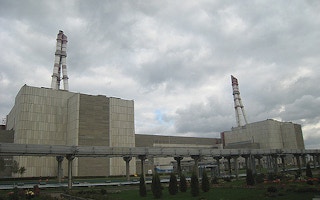When it was in operation in the 1980s and 90s, Lithuania’s Ignalina nuclear power plant had one of the most powerful reactors in the world. Today, the plant that was built to supply power to a large part of what was the Soviet Union’s Baltic region lies silent.
Lithuania joined the European Union in 2004, and one of the EU’s entry requirements was that Ignalina – similar in design to the Chernobyl power plant in Ukraine, with no proper containment shell to restrict any escaping radioactivity – must be closed.
Backers of nuclear power say that using the industry’s potential is a key way of tackling the challenges posed by climate change.
Critics say nuclear is too dangerous and costly, and the disposal of growing quantities of highly-radioactive nuclear waste is a problem yet to be solved.
Financial burden
The authorities at Ignalina say the whole decommissioning process, including the decontamination of thousands of tons of equipment and building materials, is likely to cost at least €3 billion.
Much of the cost has so far been funded by the EU. But Lithuania − one of the less economically developed countries within the EU, with under three million people − will in the future have to take on more of the financial burden of dismantling the plant.
A plant spokeswoman says the decommissioning process will take the 2,000 workers at present on site until 2038 to complete. In addition, there is the problem of the disposal of long-term nuclear waste, initially to be stored on site in a series of steel casks.
After 50 years, a final storage place will have to be found. According to publicity material at the plant, scientists are considering various options, including deep ice cap storage or even launching the waste into space, but burying it in deep caverns within Lithuania seems to be the preferred option.
There are other unquantifiable financial and social costs involved in the decommissioning project. When Ignalina was being built in the 1970s, a town with a population of 30,000 was built nearby to house nuclear plant workers and their families.
The town − called Snieckus under the Soviets, and now known as Visaginas − was once considered to be off limits to those not associated with the nuclear plant. Now it is an employment black spot.
Residents – more than half of whom are ethnic Russians brought in over the years to work at Ignalina – are angry that their source of employment has been taken away.Locals say many people have left, and there are now drug problems in the town.
At one stage, Lithuania proposed the construction of a new nuclear plant on the Ignalina site.
In a referendum in 2012, more than 60 per cent of Lithuanians voted against a new nuclear facility. Despite this, the government has so far refused to rule out building another nuclear plant.
Neighbour dispute
The Lithuanian government is at present in dispute with neighbouring Belarus about their construction of a nuclear power plant that would be less than 50 kilometres from Vilnius, the Lithuanian capital.
When it was in operation, Ignalina supplied up to 70 per cent of Lithuania’s electricity. Martynas Nagevicius, president of the Lithuanian Renewable Energy Confederation, says that due to an over-dependence on nuclear, the development of other power sources − such as the country’s considerable biomass potential − was neglected.
The technical problems and costs of decommissioning have become a worldwide issue. According to the International Atomic Energy Agency (IAEA), the UN body that oversees developments across the nuclear sector, 157 nuclear power reactors around the globe have been permanently shut down, but only 17 of these have so far been fully decommissioned.
And the decommissioning queue is getting longer by the day. The IAEA says that more than half the 442 nuclear reactors at present operating are nearing the end of their licensed lifespans.










